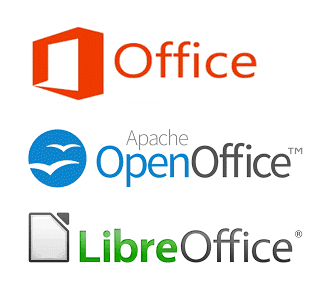Microsoft Office, OpenOffice, and LibreOffice are all office productivity suites that provide word processing, spreadsheet, and presentation software. Here are some key differences and similarities between the three:
Features: Microsoft Office has a comprehensive set of features and tools for productivity, including advanced formatting, collaboration tools, and integration with other Microsoft products. OpenOffice and LibreOffice have similar features, but they may not have as many advanced features as Microsoft Office.
Compatibility: Microsoft Office is the most widely used office suite and has the best compatibility with other Microsoft products. OpenOffice and LibreOffice are open-source software, which means they are compatible with a wider range of platforms, including Windows, macOS, and Linux.
Cost: Microsoft Office is a paid software, and users need to purchase a license to use it. OpenOffice and LibreOffice are both free and open-source, which makes them more accessible to users who cannot afford a paid software.
User Interface: Microsoft Office has a well-designed, polished user interface that is easy to use and intuitive. OpenOffice and LibreOffice have a similar user interface, but it may not be as polished as Microsoft Office's.
Support: Microsoft Office provides extensive customer support and resources, including tutorials, online help, and user communities. OpenOffice and LibreOffice have fewer resources, but they do have user communities and forums where users can seek help and support.
Microsoft Office is a powerful and comprehensive productivity suite, but it comes with a higher cost. OpenOffice and LibreOffice are free alternatives that are suitable for basic productivity tasks but may not have as many advanced features as Microsoft Office. The choice between the three depends on the user's specific needs and budget.
OpenOffice and Microsoft Office are both office productivity suites that provide word processing, spreadsheet, and presentation software. Here are some key similarities and differences between the two:
Features: Both OpenOffice and Microsoft Office provide similar features for productivity, including advanced formatting, collaboration tools, and integration with other software products. However, Microsoft Office has a more comprehensive set of features and tools.
Compatibility: Microsoft Office has better compatibility with other Microsoft products, such as SharePoint and OneDrive, and is the most widely used office suite. OpenOffice is open-source software and is compatible with a wider range of platforms, including Windows, macOS, and Linux.
Cost: Microsoft Office is a paid software, and users need to purchase a license to use it. OpenOffice is free and open-source, which makes it more accessible to users who cannot afford a paid software.
User Interface: Both OpenOffice and Microsoft Office have well-designed user interfaces that are easy to use and intuitive. However, some users may prefer the design and layout of one over the other.
Support: Microsoft Office provides extensive customer support and resources, including tutorials, online help, and user communities. OpenOffice has fewer resources, but it does have a user community and forum where users can seek help and support.
LibreOffice and Microsoft Office are both office productivity suites that provide word processing, spreadsheet, and presentation software. Here are some key similarities and differences between the two:
Features: Both LibreOffice and Microsoft Office provide similar features for productivity, including advanced formatting, collaboration tools, and integration with other software products. However, Microsoft Office has a more comprehensive set of features and tools.
Compatibility: Microsoft Office has better compatibility with other Microsoft products, such as SharePoint and OneDrive, and is the most widely used office suite. LibreOffice is open-source software and is compatible with a wider range of platforms, including Windows, macOS, and Linux.
Cost: Microsoft Office is a paid software, and users need to purchase a license to use it. LibreOffice is free and open-source, which makes it more accessible to users who cannot afford a paid software.
User Interface: Both LibreOffice and Microsoft Office have well-designed user interfaces that are easy to use and intuitive. However, some users may prefer the design and layout of one over the other.
Support: Microsoft Office provides extensive customer support and resources, including tutorials, online help, and user communities. LibreOffice has fewer resources, but it does have a user community and forum where users can seek help and support.
Overall, Open Office and LibreOffice are a free and open-source alternative to Microsoft Office that provides similar features and tools for productivity. However, Microsoft Office has a more comprehensive set of features, better compatibility with other Microsoft products, and more extensive customer support and resources. The choice between the two depends on the user's specific needs, budget, and preference for software products.
The Wizard has used Libre Office for several years now, for basic and more than basic functions. It has always worked for me.
Source: Some or all of the content was generated using an AI language model


No comments:
Post a Comment